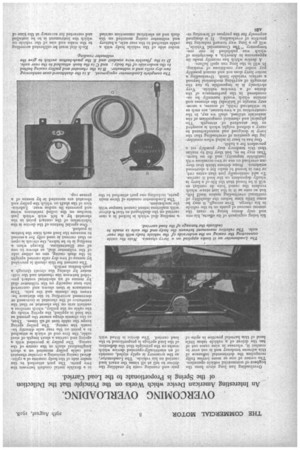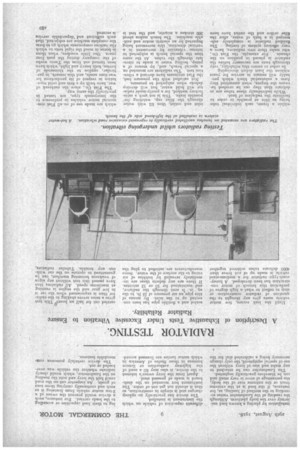OVERCOMING OVERLOADING.
Page 8

Page 9

If you've noticed an error in this article please click here to report it so we can fix it.
An Interesting American Device which Works on the Principle that the Deflection of the Spring is Proportionate to the Load Carried.
Overloading has long since been the bugbear of commercial vehicle operation. The owner of one or more lorries fully recognizes the detrimental influence of this adverse tendency and. is out ever to combat it, whereas an nine cases out of ten the driver of a vehicle takes little heed of this harmful practice in spite of
his being cognizant of its effects, his one and only desire being to cram the utmost amount of goads on to the vehicle in his charge. True enough, it May be some little time before the disability of Continual overloading makes itself felt, but so aura as it is the last straw which renders the camel 'hors de combat so will it be found that the life of a lorry is wholly dependent on the load it carries. To add continually just that-extra cwt. or two is bound to make for a shortened existence. Some drivers think that they can overload on one or two occasions with justifiable impunity, and do no harm. That may be so, but they fail to realize that this tendency may possibly set a precedent for a habit.
One has to bear in mind when considering the question of overloading that the lorry is designed and manufactured to carry a defined weight which is accepted as the standard of strength. The physical and chemical composition of the materials utilized, shall we say, in the construction of a two-tanner, are such as to withstand. (with, of course, a necessary margin of latitude) the stresses and strains which would normally be encountered in the performance of the duties of a two-ton vehicle. Very obviously it is impossible to tax the strength of anything mechanical beyond a eel-fain variable Emit. Overloading .a motor lorry does not and cannot possibly pay under any conditions of working. It will in the long run spell failure.
A device which has recently made its appearance in America, a description of which was published in our contemporary "The Commercial Vehicle." will go a long way toward reducing the practice of overloading. It is designed expressly for the purpose of lowering re
A.28 pair and running costs by enabling the driver to tell at all times the exact load carried on his vehicle. The Lowciometer, as the accessory is aptly styled, consists of art electrically-operated device which works on the principle that the deflection of the load springs is proportioned to the load carried. The device is fitted with a reading dial which is locked in a case carried on the dashboard so that t driver with malicious intent cannottamper with the mechanism.
The Loadometer consists of three main parts, including one part attached to the under side of the vehicle body with a cable attached to the rear axle, a battery and voltmeter casing mounted on the dash and an electrical connection carried in a flexible metal conduit between the two parts. The part attached to the under side of the body consists of a cylindrical casing enclosing a circular rheostat and cable pulley mounted on a short longitudinal shaft at the centre of the casing. The pulley is provided with a spring and carries a short length of steel cable, the free end of which is attached to a point on the rear axle directly beneath the casing. The pulley spring keeps the cable taut at all times. Thus, as the chassis drops nearer the ground as the load is applied, the spring winds up the cable on the pulley, which revolves a contact arm on the rheostat so that the resistance of the rheostat is increa6ed or decreased according to the distance between the chassis and the axle. This resistance is than shown and converted into tons capacity on the voltmeter dial by means of an electrical contact provided between the rheostat and the voltmeter by closing the circuit through a. push-button switch.
The current for this circuit is provided by means of two dry cells carried upright in the dash casing, one on either side of the voltmeter dial, as shown in one of our illustrations. Except when a reading is to be taken, the circuit is open so that current is used only for a second to measure the load each time the button is pushed.
One special feature of the device is the lubrication of the contact point in the rheostat by a felt wick which just touches on the coiled resistance wires and prevents its undue wear. Lubrication of the shaft on which the pulley and. rheostat are mounted is' by means of a grease cup.
Each dial must be calibrated according to the mike and size of the vehicle on which the instrument is to be installed and corrected for accuracy at the time of
installation by placing a known load uniformly over the body platform. Although the reading of the Loadometer varies according to the method of loading, as, for instance, if the load is at the extreme front Or the extreme rear of the body, the percentage of error is very small and cm be therefore practically neglected.
The Loadometer can be attached to any make and size of lorry without the use of special equipment, the only change necessary being a calibrated dial for the different capacities of vehicle on which the instrument is installed.
The device has practically no upkeep charges rind is simple in construction, so that it should not get out of order. The instrument box mounted on the dashboard is made of pressed steel.
Apart from the lorry owner's interest io the device, it also may fill a need of the highway autherittes or licence bureaus in those States of America in which motor lorries are licensed accord
ing to their load capacities or according to the loads carried. For instance, such a device would prevent the owner of a 2-ton motor vehicle from licensing it as such and continually carrying three tuns of goods. An inspector out on the road could halt the lorry and note the reading on the Loadometex, which would clearly indicate whether the vehicle was overloaded or not.
The device certainly possesses commendable features.






















